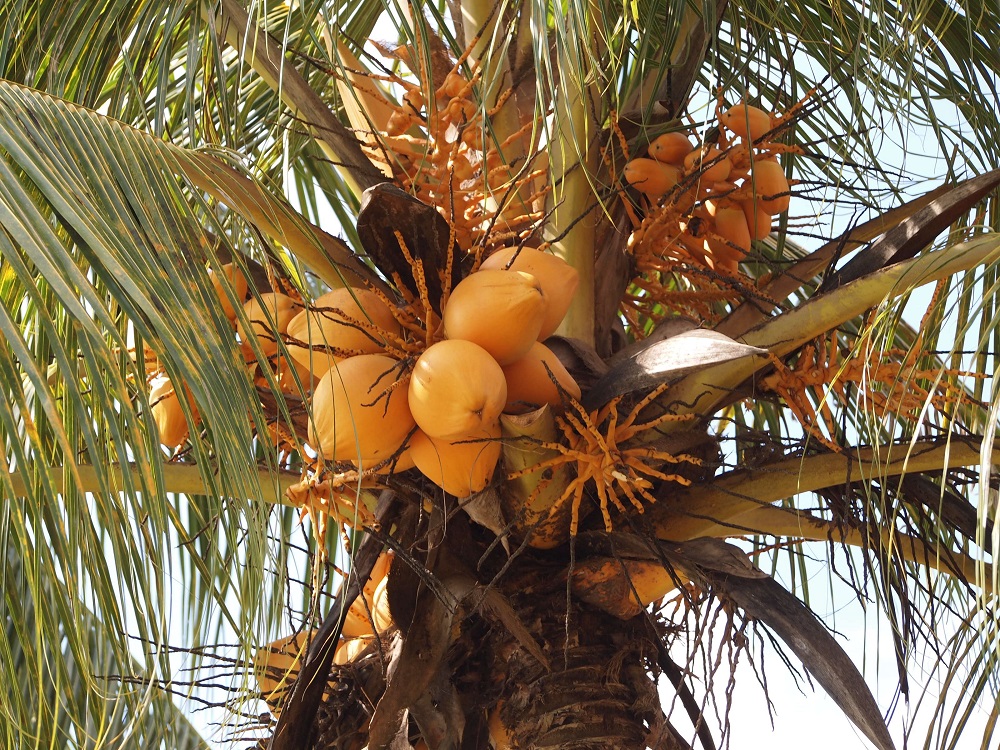VANILLA BEANS | SOYBEAN OIL | SOYMEAL & CAKE | COCOA BEANS | COFFEE BEANS
How to grow COCONUT in Uganda
 Coconut in Uganda
Coconut in Uganda“Ekinazi” as locally called, coconut palm is a feather-leaved long flowing tree of a palm family.
The coconut tree (Cocos nucifera) is a member of the family Arecaceae (palm family) and the only species of the genus Cocos.
The term coconut can refer to the whole coconut palm or the seed, or the fruit, which, botanically, is a drupe, not a nut.
The spelling cocoanut is an archaic form of the word. The term is derived from the 16th-century Portuguese and Spanish word coco meaning "head" or "skull", from the three indentations on the coconut shell that resemble facial features
The palms curved trunks lend a tropical effect when grown as a background or a free standing specimen for any land scape.
Coconuts are known for their versatility ranging from food to cosmetics.
Common Coconut varieties in Uganda
There varieties of coconut are based on place of origin, shape, and size of the palms.
Some of the coconut palm varieties include; the dwarf coconut palms like Malayan dwarf.
Contact us here to buy Coconut fruits and Coconut Seedlings Seedlings in Uganda
Soil requirements for growing Coconut in Africa
Coconut palms grow well in a wide range of soil types. However, they prefer sandy soils to sandy loam soils with a pH range from 5.0 to 8.0.
How to propagate coconut on your farm
The coconuts are propagated using seeds, and these take about 3 months to germinate under ideal conditions.
Contact us here to buy Coconut fruits and Coconut Seedlings Seedlings in Uganda
How to plant coconut in Uganda
Coconut palms are a perfect choice for both landscaping and interior scaping.
To grow a coconut palm as a house plant, use a container at least 10 inches deep and large enough in diameter to hold the nut.
Half fill the container with a potting soil mixture.
Soak the coconut to use for planting like 2 hours as this helps to fasten propagation.
Then plant it with the pointed end down and the end attached to the tree upward.
About a third of the nut should be above the soil level.
Water frequently, keeping the soil moist but not wet.
Alternatively you can direct seed the coconut plant into your yard.
Choose a site with well drained soil in partial shade.
Place the nut on its side in a shallow hole, burying only the lower third of the nut.
Water it thoroughly twice a week.
Under ideal conditions, coconut will germinate in 3 months, but otherwise it may take to up to 6 months.
A young coconut palm grows rapidly to give multiple leaves which develop in to a trunk in about five years.
Contact us here to buy Coconut fruits and Coconut Seedlings Seedlings in Uganda
How best to Harvest Coconut in Africa
Coconut palm starts fruiting 6-10 years after the seed is sown.
Once the plant has stared fruiting harvesting of coconuts can be done throughout the year.
Picking the fruits requires a skilled climber or may be cut from the ground using a knife attached to a long pole.
About the Market and Uses of Coconut
The hundreds of uses of the coconut plant make it a desirable produce on most food and processing markets.
In Uganda, the coconut is a high end produce found in markets like Nakaseero and other grocery places.
The coconut palm is grown throughout the tropics for decoration, as well as for its many culinary and nonculinary uses; virtually every part of the coconut palm can be used by humans in some manner and has significant economic value.
The various parts of the coconut have a number of culinary uses. The seed provides oil for frying, cooking, and making margarine. The white, fleshy part of the seed, the coconut meat, is used fresh or dried in cooking, especially in confections and desserts such as macaroons.
The stiff midribs of coconut leaves are used for making brooms in India
The husk and shells can be used for fuel and are a source of charcoal.
Coconut trunks are used for building small bridges and huts
The roots are used as a dye, a mouthwash, and a medicine for diarrhea and dysentery.
Contact us here to buy Coconut fruits and Coconut Seedlings Seedlings in Uganda
Quick Tips for planting a coconut plant
- Depending on where you to seat your coconut palm you can use a container or directly seed the pod.
- Get a healthy coconut pod with slosh or that has water inside.
- Soak the pod for about 2 hour as it helps fasten germination.
- For a palm meant for indoors get a container 10 inches deep and wide enough to seat the coconut palm
- Half fill the container with a soil mixture place in the coconut pod.
- Make sure the pointed end put down in the soil and the part that was attached to the tree facing up.
- Alternatively, you can place the pod direct into the soil outside
- Open up a hole slightly bigger than the pod intended for planting.
- Enhance it with compost but it’s not a must, then plant in your pod.
- Cover the pod with the soil but make sure a third of it remains outside.
- Water often to keep the germinating pods moist
Contact us here to buy Coconut fruits and Coconut Seedlings Seedlings in Uganda
Have a Question or Great Story About This Plant Guide?
Do you have a Question or Comment about this plant Guide? Then Share it!
If you haven't yet found what you were looking for or you need detailed information about the subject matter on this page then... feel free to ask our business travel consultants. |




